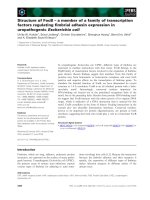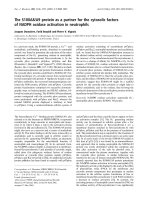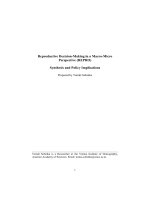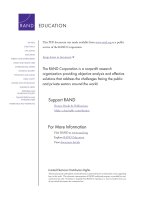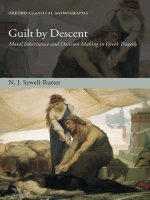Factors afecting couples decision amking in comtemporary wedding event decoration
Bạn đang xem bản rút gọn của tài liệu. Xem và tải ngay bản đầy đủ của tài liệu tại đây (1.91 MB, 81 trang )
UNIVERSITY OF ECONOMICS HO CHI MINH CITY
International School of Business
Dinh Thi To Nhu
FACTORS AFFECTING COUPLE’S
DECISION MAKING IN
CONTEMPORARY WEDDING EVENT
DECORATION: FAMILY INFLUENCE,
SOCIAL STATUS, AND PERSONAL
VALUES
MASTER OF BUSINESS
(Honours)
Ho Chi Minh City – Year 2014
UNIVERSITY OF ECONOMICS HO CHI MINH CITY
International School of Business
Dinh Thi To Nhu
FACTORS AFFECTING COUPLE’S
DECISION MAKING IN
CONTEMPORARY WEDDING EVENT
DECORATION: FAMILY INFLUENCE,
SOCIAL STATUS, AND PERSONAL
VALUES
ID: 22110040
MASTER OF BUSINESS
(Honours)
SUPERVISOR: Dr. VO THI NGOC THUY
Ho Chi Minh City – Year 2014
i
Tables of Content
Chapter 1: Introduction 1
1.1 Research background 1
1.2 Research objectives 3
1.3 Scope of the study and methodology 4
1.4 Research contribution 4
1.5 Research structure 5
Chapter 2: Literature review 7
2.1 Concept of contemporary wedding and wedding event decoration 7
2.1.1 A contemporary wedding 7
2.1.2 Wedding event decoration 8
2.2 Definition of Consumer behavior and theories of factors
affecting consumer purchasing decision 8
2.3 Previous researches about factors affecting couple’s decision
making and identifying hypotheses in this study 10
2.3.1 Family influence 11
2.3.2 Social status 15
2.3.3 Personal values 16
Chapter 3: Research Methodology 21
3.1 Research process 21
3.2 Research design 22
3.3 Measurement scales 23
3.4 Quatitative pilot research and results 25
Chapter 4: Data Analysis 29
4.1 Descriptive statistic of sample 29
4.2 Adjustment of hypotheses and research model 37
ii
4.3 Testing of normal distribution 38
4.4 Regression analysis 39
4.5 Findings 42
Chapter 5: General conclusion 46
5.1 Contributions of research 46
5.1.1 Theoretical contributions 46
5.1.2 Managerial implications 47
5.2 Limitations and further researches 48
5.3 Conclusion 49
References
Appendix
iii
List of Figures and Charts
Figure 2.1 Conceptual model: Factors affecting couple’s decision
making in contemporary wedding event decoration: Family influence,
social status and personal values 19
Figure 4.1: Adjustment model of the research 37
Chart 3.1 Research process 21
iv
List of Tables
Table 2.1 Theories of factors affecting consumer purchasing decision 10
Table 2.2 Variables and previous researches 11
Table 3.1 Cronbach alpha result of pilot test 26
Table 3.2 KMO and Bartlett's Test result of pilot test 26
Table 3.3 Pattern Matrix result of pilot test 27
Table 4.1 Demographic statistics result 30
Table 4.2 Cronbach’s Alpha result of all variables 32
Table 4.3 KMO and Bartlett's Test result of independent variables 33
Table 4.4 Pattern Matrix of items 34
Table 4.5 KMO and Bartlett's Test result of Dependent variable 36
Table 4.6: Pearson Correlation Coefficient result 39
Table 4.7 Regression Analysis and Anova’s test Result 41
Table 4.8: Hypothesis testing 44
Abstract
Many recent years, Vietnamese young couples tend to organize their wedding event
including many items of decoration such as photo booth, gallery table, aisle décor, stage
backdrop, guest tables’ decoration and lighting system. This absolutely generate more
expense for their wedding; however they still determine to use the service. So, what
factors really affect consumption in wedding reception decoration?
The aim of this thesis is to investigate and identify the real impacts on couple’s decision
making in contemporary wedding event decoration, and to provide practical contributions
for all suppliers of this field in Ho Chi Minh City for the next years. This study was
conducted in from September 2013 to April 2014 in inner areas of the city. 135 couples
who have just married within three years that used wedding event decoration served as
subjects in a study designed to investigate. All responses of the questionnaires were made
on a 5-point Likert scale with the five elements that required investigating, including
family relations, wife/husband attitudes, social status, conformity and the need of
uniqueness.
The results reveal that social status is the most important impact on the decision making
of couples to use the wedding event decoration. In addition, the communication of family
members with couples makes a strong effect on their final decision. Factors of
conformity, the need of uniqueness and wife/husband attitudes also effect on couple’s
decision making.
Keywords: couple’s decision making, family relations, husband/wife attitudes, social
status, conformity, need of uniqueness, wedding event decoration, Ho Chi Minh City
1
Chapter 1: Introduction
This chapter is a beginning of the thesis that includes five sections. The research
background is firstly presented. Then, the research objectives of the thesis are
discussed. The chapter also introduces the contribution and scope of the study.
Finally, the research structure is presented.
1.1 Research background
Gidoni (2000) states that a contemporary Japanese wedding consists of traditional
customs and Western-style ceremony because of economic motivations.
Similarly, a contemporary Vietnamese wedding combine the two parts. After
wearing traditional outfits to join in a traditional wedding ceremony with a list of
rituals, bride and groom are ready to change their custom to Western style ones to
celebrate their wedding event with their friends, colleagues and relatives in a
public institution. In this event, many items of a Western-style wedding can be
applied such as white wedding gown, wedding cake, champagne fountain,
dancing performance (Nguyen & Belk, 2012) and decoration. Because of
generating many things for a wedding event, budget for a contemporary wedding
is certainly higher than in the past. According to a report of Home Credit group,
an average of wedding budget of a couple is around VND100 million for 300
guests (Le, 2013).
Wedding industry is more attractive for investors such as wedding event and
convention, photography, wedding dress and make up, and decoration. A report
of Doanh Nhan Sai Gon (2013) provides information of VND ten thousand
billion of profit in wedding event and convention field, an increase of 15%
compared to the last year. More and more wedding dress stores and studios have
opened with many updated-Western styles in their showrooms. Particularly, in ten
2
recent years, wedding decoration field have developed very fast with many big
suppliers like Vietnam Wedding Planner, Bliss, Confetti, V-Party, Hajime, Marry
Me, Lemon Tree, Cleo, and so on. Most of the decoration styles currently tend to
follow Western wedding concept from photo booth, gallery table to the stage
backdrop with many candles, fresh flowers, glasses and crystals. A couple easily
search on the Internet through Google or Bing to find out the common style of
wedding event decoration and choose one supplier to make it on their wedding
day.
Couples recently express their interesting on decoration in wedding event in Ho
Chi Minh City (HCMC) for a more pleasure and memorable wedding, as the
author observed through the Internet, online newspapers and social media and the
real experience of communications between the author and friends who have just
married. However, wedding event decoration surely generates an amount of
budget that leads to find hard for them to determine to consume the service. The
number can increase to 10% of intend budget for a wedding (Le, 2013). So, what
factors really affect consumption in wedding event decoration?
A recent research of Nguyen & Belk (2012) mentions about the changes of
wedding consumption in Vietnam after Doi Moi from some aspects such as social
values, social relations, and gender roles. Especially, in the research, they state
that filial piety is still one of the most important fundamental values of
Vietnamese kinship. That can affect wedding consumption because couples
respect opinions of their elder members in the family. In addition, as a study of
Cotte and Wood (2004), “family socialization is a rich field in consumer
behavior” (p.78). The research of Nguyen & Belk (2012) also points out the
social status element in wedding consumption when young couples include
Western wedding concept into their weddings to show the social status or family
status by spending some luxury services. Another research shows that couples
3
focus on their wedding as a performance day of their status, society level or the
wealth instead of happiness of the day they can share their lives together (Adrian,
2003). According to the research of Nguyen & Belk (2012), values also make an
effect on wedding consumption because of the importance and unique of a
wedding as Vietnamese rituals. Clawson and Vinson (1977) suggest that personal
value is considered as one of the strongest impacts on consumer behavior.
Particularly, Partner (2001) states about a vital role of lifestyle in a special event
such as weddings.
These results of researches which were conducted in many countries as well as in
Vietnam found out factors affecting to consumer decision making in general.
Many weddings recently have been included decoration that opens opportunities
for event decoration suppliers to provide many services in Ho Chi Minh City.
This study raises research objectives about exploring the real factors affecting on
final decision making of couples that can create more suitable services to save
time of consultancy and persuasion to improve competitive advantage in market.
1.2 Research objectives
Because consumer behavior is a rich field that need to be explored, many
researches were conducted to find out the factors that affecting consumer
behavior decision making. These researches help managers, businesses can
understand thoroughly about the customer insight and offer the best products and
services for them. Thus, based on the literature review of consumer behavior and
affecting of some factors, and especially in the context of wedding event
decoration in Ho Chi Minh city, the study aims:
To propose a model that predicting some factors affecting wedding event
decoration in Ho Chi Minh city
4
To explore the real impacts on couple’s decision making in contemporary
wedding event decoration
To evaluate how each factor affects to couple’s decision making
The author would like to provide the findings for wedding decoration suppliers in
Ho Chi Minh City to understand more about their customers and the problems in
the competitive market, then constantly design a suitable service for couples to
save time and expense.
1.3 Scope of the study and methodology
The data collecting will be divided into two parts including pilot test and main
test. The pilot test is conducted with 20 respondents to pre-test how they
understand the variables and questionnaire. The main test is then conducted with
135 respondents.
This research will be conducted in inner areas of Ho Chi Minh City, included
District 1, 2, 3, 4, 5, 6, 7, 8, 9, 10, 11, Tan Binh, Phu Nhuan, Go Vap, and Binh
Thanh. The interviewees will be couples that have just married within three years
that used wedding event decoration.
The purpose of the research is to examine the conceptual model. The
measurement scales are estimated using Exploratory Factor Analysis (EFA) to
test the reliability and validity. The multiple regressions in Statistical Package for
the Social Sciences (SPSS) version 16 would be conducted to evaluate correlation
between dependent and independent variables.
1.4 Research contribution
The research is intended to contribute twofold contribution including theoretical
contributions and managerial implications. The research is expected to reach new
5
aspects of influent factors on consumption of wedding event decoration based on
the previous researches and provide some managerial implications for businesses
in this field in Ho Chi Minh City.
First, the research will apply the knowledge of Kotler and Armstrong (2011) of
factors affecting consumer purchasing decision to new product, a wedding event
decoration by performing family influence, social status and personal values and
how much they affecting. Although many international researchers expressed
their interests in these factors affecting on wedding consumption; however, they
have not examined thoroughly the effects of three factors that mentioned above to
couple’s decision making on wedding event decoration. In Vietnam several
researches also were conducted with social status, social relations and gender
roles factors (Nguyen & Belk, 2012) to analyze their impacts on wedding
consumption. Therefore, this study has been quite new to contribute the way of
measuring factors affecting to using wedding event decoration in Vietnam,
particularly in Ho Chi Minh city, especially examine deeply about influence of
family influence and social status on couple’s decision, and explore new aspect of
personal values that adopted by from global researches.
Second, the research can help wedding event decoration companies understanding
about real factors can affect directly to final decision of couples. Based on
customer insight, they can offer them more flexible and diversified services to
choose and determine, save time and budget for a pleasure wedding as customers
could wish. In addition, through this study, marketing managers of wedding
services can create more interesting and attractive marketing campaign to reach
more customers in the competitive market.
1.5 Research structure
This study includes five chapters that listed as below,
6
Chapter 1 – Introduction: This chapter is a beginning of the thesis that includes
five sections. The research background is firstly presented. Then, the research
objectives of the thesis are discussed. The chapter also introduces the contribution
and scope of the study. Finally, the research structure is presented.
Chapter 2 – Literature review and hypothesis development: This chapter includes
a concept of a contemporary wedding and wedding event decoration, theories of
consumer decision making and consumer, the model of process of making
decision and some relevant researches and identifying significant factors affecting
to final decision making of couples as well as the conceptual model and its
hypothesis.
Chapter 3 – Research methodology: This chapter consists four sections. First,
research process is presented for clear steps to follow in the study. Next, the
research design is discussed and measurement scales are listed as adopting from
previous researchers. Final, the chapter includes the pilot test and results to
support for measurement scales.
Chapter 4 – Data analysis: This chapter describes how each measurement scale
was evaluated and the result of testing hypothesis, including sample description,
measurement scale data analysis, and regression analysis. The findings are next
discussed.
Chapter 5 – General conclusion: This chapter presents the theoretical
contributions and managerial implications of the research, the limitations, some
directions for further research and conclusion.
7
Chapter 2: Literature review
This chapter includes a concept of a contemporary wedding and wedding event
decoration, theories of consumer decision making and consumer, the model of
process of making decision and some relevant researches and identifying
significant factors affecting to final decision making of couples as well as the
conceptual model and its hypothesis.
2.1 Concept of contemporary wedding and wedding event decoration
2.1.1 A contemporary wedding
Leeds (2002) defines that a wedding marks a happy ending of a romantic love of
two persons, who want to share their life together. In this event, couples also
make their commitments and devotion in front of their families, relatives and
friends. In Vietnam, a wedding is certainly considered as one of the most
important ceremonies. Based on traditional rituals, cultural values and family
perspective, a wedding generates many stages for both bride and groom to
prepare and implement for a long time (Nguyen & Belk, 2012). There are a
variety of things to determine to purchase or rent for a wedding with a big
intended budget for the two families of bride and groom as the Vietnamese
culture.
In addition, a contemporary wedding is organized more complicated than in the
past because of enculturation of Western wedding style in the two biggest cities
of Vietnam, Hanoi and Ho Chi Minh city. In the transition period to
modernization economy, Vietnamese wedding day is influenced by the global
flow consumer goods such as wedding gowns, wedding cakes, fresh flower
decoration, photographs and so on (Nguyen & Belk, 2012). When media, the
Internet and social website are improved and popularized, information about
8
lavish wedding are updated through movies, bridal magazines, celebrity
weddings, and advertising, Vietnamese brides dream about a fantastic wedding
ceremony. Thus, wedding event decoration is focused on and developed
extremely fast in recent years that followed the Western-style wedding.
2.1.2 Wedding event decoration
A contemporary wedding including event decoration can create a romantic, or
interesting, or artistic atmosphere for guests’ feeling (Ying, Di & Mahui, 2012).
In this study, wedding event decoration is a term of making photo booth, gallery
table, aisle and stage backdrop decoration, guest table’s decoration and lighting
system in the hall of wedding event, that based on what wedding service suppliers
in Ho Chi Minh city and Hanoi are offering for young couples.
2.2 Definition of Consumer behavior and theories of factors affecting
consumer purchasing decision
According to Schiffman and Kanuk (2007), consumer behavior is the behavior
that consumers find ways to search for, purchase, use, evaluate and transfer
products or services can satisfy their needs and expectation. Among four types of
goods including consumable goods, durable goods, specialty goods and industrial
goods, wedding is considered as a special service package because of its ritual
characteristics and a kind of nondurable goods (Hai, Krueger & Postlewaite,
2013). A wedding can be organized just a time in couple’ lifetime, so it needs to
be consumed a huge budget for many things of preparation to have perfection,
impression or celebrity-like event (Daniels & Loves, 2007). Especially, brides
tend to spend for a dream wedding because of affecting by their children fairy
stories or they can spend more intend budget than they could afford if having
much pressure from their family or their reference group, shared by Daniels &
Loves (2007).
9
People make decisions every day to consume goods or services to satisfy their
needs. Based on the theory about “what they buy”, “where they buy”, “how much
they buy”, “when they buy”, and “why they buy”, suppliers can find out their
characteristics of consumer buying decisions. However, the reason why
consumers choose to buy a product or use a kind of service is relatively difficult
(Kotler & Armstrong, 2011). Kotler and Armstrong (2011) also said that
consumers do not realize an exact reason for their buying and how much factors
affecting on their choice.
The theory proposed by Philip Kotler in his book “A Principle of Marketing” in
2011 presses the four strong factors affecting consumer purchasing decision
making including cultural factors, social factors, personal factors and
psychological characteristics (see more in Appendix). The implication from this
theory is useful for marketers to understand why consumers would like to
purchase their products or services, especially pay attention about many levels of
factors from broad cultural and social influences to motivation, beliefs, and
attitudes of a person, but cannot control these elements.
In social factors, it includes family, reference groups, and roles and status for the
impacts on consumer behavior. Cultural factors consist of culture, sub culture,
and social status. Personal factors include age and life cycle stage, occupation,
economic situation, lifestyle, personality and self-concept. Motivation,
perception, learning and beliefs and attitudes are elements of psychological
characteristics.
10
In addition, there are some theories are proposed as table below:
Table 2.1 Theories of factors affecting consumer purchasing decision
Authors
Factors
Year of study
Stanton
Attitudinal factors, Physical factors,
Social factors
1997
Lancaster and Reynold
Physical factors, Social factors and
Cultural factors
1999
Straughan and Roberts
Life Style and Demographic factors
1999
Pride and Ferrell
Physical factors, Social factors and
Attitudinal factors
2000
Kotler and Armstrong
Physical, Social, Cultural factor and
Personal factors
2007
Fatimah Furaiji,
Malgorzata
Latuszynska, Agata
Wawrzyniak
Cultural factors, Social factors,
Personal factors, Physical factors and
Marketing mix
2012
2.3 Previous researches about factors affecting couple’s decision making and
identifying hypotheses in this study
These theories above were applied in afterwards researches to find out main
factors affecting to consumer buying decision in each specific situation and field.
In general and wedding consumption segment, there are three factors were
applied many times to conduct the researches. Based on these elements,
hypotheses will be built in order to clarify and evaluate their effect levels in
couple’s decision making in wedding event decoration in Ho Chi Minh city
context.
11
Table 2.2 Variables and previous researches
No.
Variables
Authors
1
Family influence
Childers & Rao, 1992; Cotte & Wood, 2004;
Heckler, Childers & Arunachalam, 1989; Pimpa,
2009; Jung & Kau, 2004; Grusec, 2008; Su, Zhou,
Zhou & Li, 2008; Baber & Axxin, 1998; Nguyen
& Belk, 2012.
2
Social status
Kamolwan & Wiwatchai, 2010; Daniels & Loves,
2007; Adrian, 2003; Nguyen & Belk, 2012.
3
Personal values
Caprara et al., 2006; Kamolwan & Wiwatchai,
2010; Weidmann, Hennigs & Siebels, 2007; Wong
& Ahuvia, 1998; Ghazzai & Lahmandi-Ayed,
2009; Tian, Bearden & Hunter, 2001; Nguyen &
Belk, 2012.
2.3.1 Family influence
Family influence is one of the most important factors to consumer buying
decision (Childers & Rao, 1992; Cotte & Wood, 2002; Kotler & Armstrong,
2011). According to Heckler, Childers and Arunachalam (as cited in Childers &
Rao, 1992), family members can affect “norms, attitudes, and values” of
consumers (p.199). In addition, consumers can be transmitted buying
characteristics, manners and preferences of brand to from their parents (Cotte &
Wood, 2002). Moore and her colleagues mention that family influence is “the
within family transmission of information, beliefs, and resources from one
generation to the next” (Moore et al. 2002, p.17). Kotler and Armstrong (2011)
mentions that roles of purchasing, between wife and husband change with
evolving of separate consumer lifestyles. There are two aspects of family
12
influence including family relations and husband/wife attitudes that need to be
examined in this study.
Family relations
In the relation of family, parents play an important role to individuals’ decision
making through communication, interaction, and financial aid (Pimpa, 2009).
Carlson and Grossbart (1988) also state that family influence become strongly
affecting is a result of how they communicate or interact based on their relation.
Moreover, if consumers depend on finance of their parents for purchasing new
product can be more pressure to decide what they really want (Jung & Kau,
2004). The attitudes of parents are also examined to make an effect on consumer
behavior as Grusec (2008) proposes that :
the attitudes most frequently considered have to do with the degree of warmth
and acceptance or coldness and rejection that exists in the parent-child
relationship, as well as the extent to which parents are permissive or restrictive
in the limits they set for their offspring (p.1).
Nguyen and Belk (2012) also suppose that in Vietnamese culture, parents have
responsibility of giving birth to children, bringing up them, support them to get
married and continuing to take care of their children. Therefore, the relations of
parents and their children are very close and can affect much on a child’s decision
making, especially a special goods like a wedding, one of the most important
event of a couple as well as their families. Before Doi Moi, parents’ relation with
their children is just one way in decision of purchasing a product. However, there
are many changes in Vietnamese wedding within ten recent years.
Accordingly, Nguyen and Belk (2012) conclude couples often tend to
communicate much with their parents and elder family members to make decision
13
for their wedding consumption. Some of couples find good jobs and earn much
money than their parents can afford for their wedding, even adding luxury
services are less affected by their parents. As the research of Nguyen & Belk
(2012), in some circumstances, Vietnamese young people who do not depend on
their parents’ finance, can have more freedom in making decision to purchase
goods. However, they still would like to share their opinions with their parents
and listen to them because of filial piety. Especially, some couples are still follow
opinions of their parents because of their finance support. According to a survey
of Home Credit Group, total budget of a Vietnamese wedding is estimated to
spend about a hundred million VND for 300 wedding guests at a normal wedding
restaurant. About 71% of wedding events are subsidized by parents of couple,
thus their roles of determination is, of course, more powerful (Le, 2013).
Based on these theories and afterward researches, the author proposes a
hypothesis:
H1: There will be a positive influence of family relation on couple’s decision
making in wedding event decoration.
Wife/husband attitude
In this study, because of wedding is a special goods for a couple, so final decision
is made based on joining of both, wife and husband. Because of its characteristics
of selling to couples, maintaining harmony and mutual support are important to
make decision for purchase (Mitchel, as cited in Su, Zhou, Zhou & Li, 2007). In
this situation, it is important and necessary to find out if there is an impact of
wife/husband attitude to couple’s decision making in wedding event decoration.
Wife/husband attitude is a term of concerning how they face with conflicts, solve
problems and reach the result of purchase or not (Kim & Lee, 1996; Park, 1982;
14
Qualls, 1987; Webster & Reiss, as cited in Baber & Axinn, 1998), the fairness of
communication (Commuri & Gentry, as cited in Baber & Axinn, 1998), and
sharing their decision roles (Belch and Willis, 2002). Morgan and Waite,
Thornton, Alwin and Camburn, Parson (as cited in Baber & Axinn, 1998)
proposes that “gender role attitudes influence a wide range of behaviors” (p.11)
including family decision making. A person's gender-role attitudes reflect beliefs
about the roles of men and women (McHugh & Frieze, 2006). Currently, attitudes
for men and women role in decision making have changed rapidly (Scott, Dex &
Joshi, 2008). Their perception about a modern wedding and role in family to
determine to purchase goods also improved because of an enculturation.
In some countries or among some social groups, the male partner has greater
influence than his spouse (Lasse & Becker, 1997; Casterline, Perez & Biddlecom,
1997). Jung and Kau (2004) shows that Malaysian wife has to follow her husband
in family decision. In Vietnam, the patriarchal thinking has still existed and
women are not allowed to sharing ideas or opinion in their family (Nguyen &
Belk, 2012) because of affecting from Chinese culture in a thousand years in the
past. However, Nguyen and Belk (2012) also mention that in Vietnam nowadays
people are working in a modern world, husband and wife share many issues and
lead to a fair making decision. Women can feel more freely to determine about
styles, art, or decoration things such as a wedding event decoration with support
and advice from her husband.
Based on these theories and afterward researches, the author proposes a
hypothesis:
H2: There will be a positive influence of wife/husband attitude on couple’s
decision making in wedding event decoration.
15
2.3.2 Social status
In cultural factors, social status can affect consumer buying decision in every
society. Social status is formed by long-term relatives in society and “divisions
whose members share similar values, interests, and behaviors” (Kotler &
Armstrong, 2011, p.139). In the society, members in a class can be marked as a
higher or lower status than others (Schiffman & Kanuk, 2007). In this study, the
author will examine two aspects of social status, including couple wish to show
their own class or couples of lower class would like to spend more to reach higher
status in society.
Adrian (2003) supposes weddings nowadays can show the couples’ luxurious and
wealthy family. Therefore, bride and groom focus on their wedding as a
performance day of their status, society level or the wealth instead of happiness of
the day they can share their lives together (Adrian, 2003). They express their
interests in how they look like in the wedding day, how their luxury wedding
place is decorated and if food looks great and delicious. Therefore, these couples
and their families pour big amount of money into a fantastic and lavish wedding
consumption by adding many items related to Western style (Nguyen & Belk,
2012).
In addition, Nia and Zaichkowsky (as cited in Kamolwan & Wiwatchai, 2010)
believe that personal satisfaction and admiration can be recognized by others by
consuming luxury goods in public area. Therefore, wedding event decoration can
help identify social class of couple or their family and the position in the society.
Some couples think that they can shine and become wealthy nobles in their
special day, so they spend a lot in spite of their true economic status (Lewis, as
cited in Daniels & Loves, 2003).
16
Based on these theories and afterward researches, the author proposes a
hypothesis:
H3: There will be a positive influence of social status on couple’s decision
making in wedding event decoration.
2.3.3 Personal values
Personal values and personal traits are two aspects of personality element of
personal factor that affecting consumer buying behavior. According to McCrae
and Costa (as cited in Caprara et al., 2006), traits show how people differ from
each other based on personal thinking, feeling and acting, while Schwartz (1992)
defines values principles of personal life through “cognitive representations of
desirable, abstract, trans-situational goals” (as cited in Caprara et al., 2006, p.3).
Similarly, Roccas, Sagiv, Schwartz & Knafo (2002) add values can be created by
the way people communicate about each other. Values also are standards or
qualities that person can hold in high regard. Thus, these values instruct the way
people live and decide what they desire to become. These internal factors can
make a strong impact on consumer decision making (Eagly & Chaiken;
Weidmann, Hennigs & Siebels, as cited in Kamolwan & Wiwatchai, 2010).
There are five aspects of personal values such as consumer ethnocentrism,
materialism, conformity, the need for uniqueness and vanity that were mentioned
in a research of Kamolwan and Wiwatchai (2010). In this research, the author
also pressed the theory of personal values of Weidmann, Hennigs & Siebels
(2007) about individual values and social related values. The first dimension is
used to describe consumers in one country thinking that purchasing products in
other countries is immoral or inappropriate because doing so is unpatriotic. The
second one mentions about the vital of possessions of material objects in life
(Richin & Dawson, 1992). These aspects are not appropriate with the goals of the
17
thesis, so they cannot apply for the wedding event decoration. The last one of
personal values is also not considered as a potential variable for the thesis
because of its definition about physical appearance, not relevant to wedding event
decoration too. Therefore, just two of five dimensions of determinants of personal
values need to be examined to interpret how they affect wedding event
decoration, including conformity and the need for uniqueness.
Conformity
A research of Kamolwan and Wiwatchai (2010) illustrated that conformity is a
changing in behavior to become suitable with a social group. Conformity is also
interpreted as a majority influence in society (Mcleod, as cited in Kamolwan &
Wiwatchai, 2010). The changes occur when social expectation and norms are
accepted can put pressure on consumers on group. Especially, Southeast Asian
consumers can focus on luxury goods for a good public display in society or in
group that they belong to (Wong & Ahuvia, 1998). They think more about
appearance (Kamolwan & Wiwatchai, 2010).
People in same groups tend to conform to their motives of other demands to
maintain the harmony among members (Markus & Kitayama, 1991). Another
research of Ghazzai and Lahmandi-Ayed (2009) examine the conformity-
characterized consumers can purchase the products that can show their same
characteristics. For Asian countries, young people nowadays can speak English
(Nowak, 2005), be familiar with American customs and easily adapt to Western
society (Gold, 1992; Nowak, 1998). They update new information and
recommendation from both domestic sources and international pages to organize
a special wedding. They put many fresh flowers on greeting tables, wear white
wedding gown that import from the America or European country, photography,
wedding cake, and so on to have a romantic wedding (Nguyen & Belk, 2012).
18
Based on these theories and afterward researches, the author proposes a
hypothesis:
H4: There will be a positive influence of conformity on couple’s decision making
in wedding event decoration.
The need for uniqueness
Everyone is a unique; however, how many percent of people in society would like
to express their uniqueness? Tian, Bearden, and Hunter (2001) define consumer’s
need for uniqueness is a different individual from others or a distinctive one
among a bigger group. However, its concept is not like non-conformity, it means
that consumers choose another different goods from each other to increase their
appearance and personal characteristics among the crowd (Tepper & Hoyle,
1996).
Especially, wedding is a special goods that can consume once or twice in a life
time, uniqueness can be considered as the important determinant for wedding
event decoration. Brides and grooms want to make sure of their wedding can
reflect their unique personality (Dee, 2006). In the wedding day, they can
combine Western services such as decoration in wedding event to satisfy their
hobbies and show their personality to guests (Nguyen & Belk, 2012). A recent
research of Teah and Phau (2012) suppose “status consumption and consumers’
need for uniqueness are found to influence attitudes” (p.5).
Based on these theories and afterward researches, the author proposes a
hypothesis:
H5: There will be a positive influence of the need of unique on couple’s decision
making in wedding event decoration.


